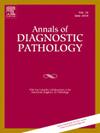Immunohistochemical markers of potential utility in identifying POLE-mutant endometrial carcinomas: An assessment of autocrine motility factor (AMF) and autocrine motility factor receptor (AMFR)
IF 1.4
4区 医学
Q3 PATHOLOGY
引用次数: 0
Abstract
POLE status determination is necessary for the molecular classification of endometrial carcinomas (EC). However, this determination is only achievable by molecular techniques, which are not available in many practice settings. A previously published study reported elevated AMF/GPI and AMFR/gp78 levels in POLE-mutant EC. We examined the relationship between POLE status and AMF and AMFR expression. Our study included 55 molecularly classified EC, assessed for AMF and AMFR immunohistochemically. Staining intensity was scored 0 (negative), 1 (weak), 2 (medium), 3 (strong), extent was scored 0 (0 %), 1 (1–25 %), 2 (26–50 %), 3 (51–75 %), 4 (76–100 %), with those parameters summed for the final score for each case. The molecular subtypes POLE mutant, mismatch repair-deficient, no specific molecular profile, p53 abnormal had mean AMF scores of 5.909, 4.643, 5.000, 4.667, respectively. The POLE-mutant subtype had a significantly higher average AMF score than POLE wild-type (POLEwt) group (p = 0.003). Using POLE mutant status as an end-point, ROC analysis showed that an AMF immunohistochemical score of 6 and above had an 81.8 % sensitivity, 61.4 % specificity, AUC of 0.708 (95 % CI, 0.565–0.851). POLE-mutant subtype had higher prevalence of a score of 6 and above than the POLEwt group (9/11 vs 17/44 cases, p = 0.010). An AMF score 6 and above increased the likelihood of being POLE-mutant by a factor of 10.496 (95 % CI, 1.592–69.212). Similarly, the POLE-mutant subtype had higher prevalence of AMFR scores of 5 and above than the POLEwt group (p = 0.023). AMF may offer some promise in identifying POLE-mutant EC with relatively high sensitivity, but suboptimal specificity indicates that it cannot be applied alone in practice. Additional studies are required to determine whether AMF can be combined with other markers to more optimally identify POLE mutant EC.
免疫组织化学标记物在识别极突变子宫内膜癌中的潜在效用:自分泌运动因子(AMF)和自分泌运动因子受体(AMFR)的评估。
子宫内膜癌(EC)的分子分类需要确定POLE状态。然而,这种测定只能通过分子技术来实现,这在许多实践环境中是不可用的。先前发表的一项研究报告了pole突变EC中AMF/GPI和AMFR/gp78水平升高。我们研究了极点状态与AMF和AMFR表达之间的关系。我们的研究包括55个分子分类的EC,对AMF和AMFR进行免疫组织化学评估。染色强度评分为0(阴性)、1(弱)、2(中)、3(强),程度评分为0(0%)、1(1- 25%)、2(26- 50%)、3(51- 75%)、4(76- 100%),并将这些参数相加作为每个病例的最终评分。分子亚型POLE突变、错配修复缺陷、无特异性分子谱、p53异常的平均AMF评分分别为5.909、4.643、5.000、4.667。POLE突变亚型的平均AMF评分显著高于POLE野生型(POLEwt)组(p = 0.003)。以POLE突变状态为终点,ROC分析显示,AMF免疫组织化学评分6分及以上敏感性81.8%,特异性61.4%,AUC为0.708 (95% CI, 0.565-0.851)。POLE-mutant亚型在6分及以上的患病率高于POLEwt组(9/11 vs 17/44, p = 0.010)。AMF评分在6分及以上,极突变的可能性增加10.496倍(95% CI, 1.592-69.212)。同样,pole突变亚型的AMFR评分在5分及以上的患病率高于POLEwt组(p = 0.023)。AMF可能以相对较高的灵敏度为鉴定极突变EC提供了一些希望,但不理想的特异性表明它不能单独应用于实践。需要进一步的研究来确定AMF是否可以与其他标记物结合以更优化地识别POLE突变体EC。
本文章由计算机程序翻译,如有差异,请以英文原文为准。
求助全文
约1分钟内获得全文
求助全文
来源期刊
CiteScore
3.90
自引率
5.00%
发文量
149
审稿时长
26 days
期刊介绍:
A peer-reviewed journal devoted to the publication of articles dealing with traditional morphologic studies using standard diagnostic techniques and stressing clinicopathological correlations and scientific observation of relevance to the daily practice of pathology. Special features include pathologic-radiologic correlations and pathologic-cytologic correlations.

 求助内容:
求助内容: 应助结果提醒方式:
应助结果提醒方式:


